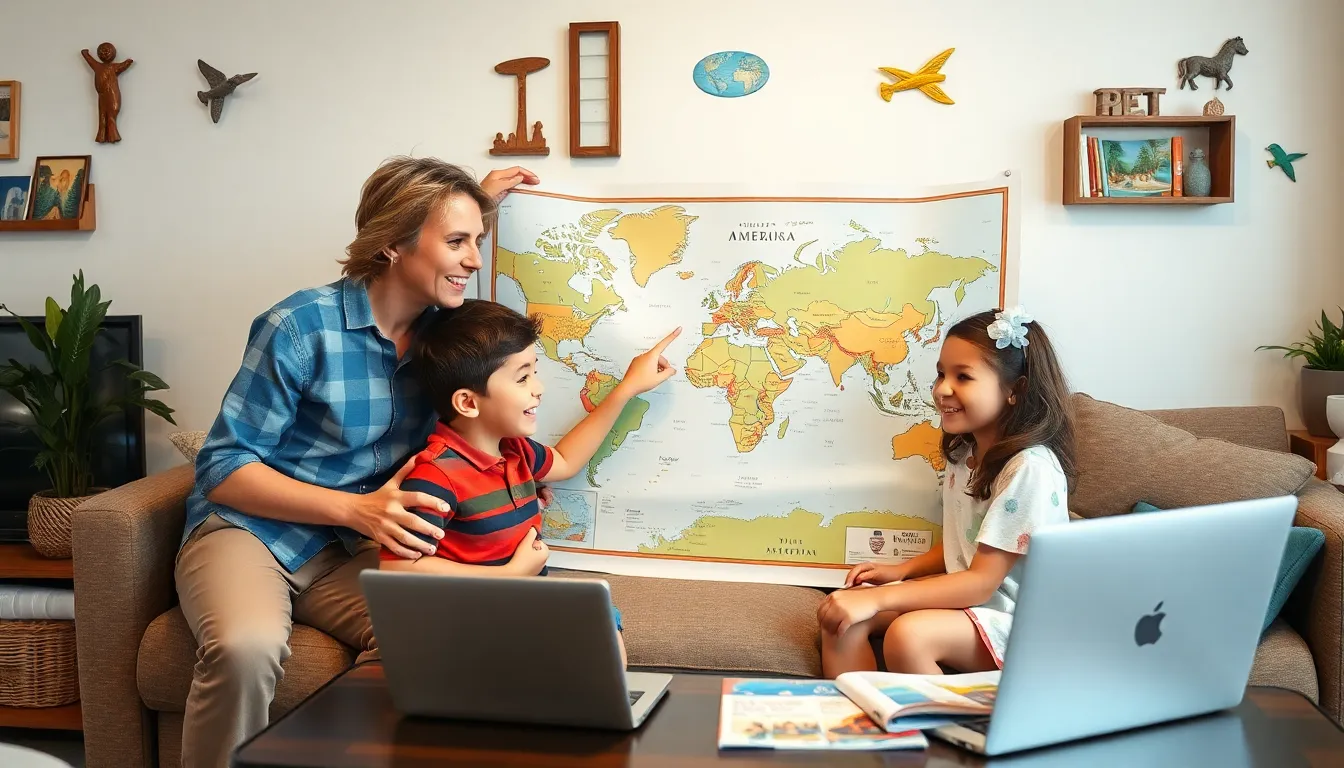Table of Contents
ToggleFamily travel can feel like herding cats—exciting yet chaotic. Whether it’s a road trip to Grandma’s or a flight to a tropical paradise, the journey often comes with its own set of challenges. But fear not! With a sprinkle of planning and a dash of humor, traveling with kids can transform from a potential circus act into a delightful adventure.
Essential Tips for Family Travel
Planning a family trip involves specific strategies to ensure an enjoyable experience. Prioritize flexibility in your itinerary. Children may need breaks, and unplanned stops can enhance the journey.
Select accommodations that cater to families. Look for hotels or rentals with family-friendly amenities like pools, kitchens, or nearby attractions. These features can make a significant difference.
Pack efficiently. Limit luggage to essentials while including activities to keep children entertained during travel. Coloring books or electronic devices provide engagement during long waits.
Involve everyone in the planning process. Seek input from children on destinations and activities. This approach fosters excitement and ensures everyone’s preferences are considered.
Consider travel times carefully. Choose flights or drives that align with children’s schedules. Traveling during nap times can lead to smoother transitions.
Stay organized. Keep important documents, tickets, and itineraries in a dedicated folder. Access to this information simplifies check-ins and reduces stress.
Create a checklist. Include items specific to children, such as favorite snacks, comfort items, or medications. This ensures no essential items are left behind.
Aim for a balance of structured activities and free time. Allowing children some downtime contributes to an enjoyable pace. This strategy encourages exploration and reduces frustration.
Stay open-minded about unexpected changes. Flexibility can lead to unexpected adventures, enhancing the family experience. Adjustments can create cherished memories.
Use technology to your advantage. Apps for maps and local attractions enhance navigation and provide real-time information. Families can use these resources to explore new areas with ease.
Planning Your Trip

Planning a family trip involves careful thought and consideration. The destination plays a crucial role in ensuring everyone enjoys the experience.
Choosing the Right Destination
Selecting a family-friendly location sets the tone for the entire trip. Prioritize places that offer activities for different age groups. Coastal destinations provide beaches for relaxation and water sports. Mountain retreats offer hiking and exploration opportunities. Urban areas often feature museums, parks, and attractions suited for families. Check for local events or festivals that might coincide with the travel dates. Considering the travel distance helps avoid fatigue. Ensure the chosen destination accommodates needs, such as medical facilities or childcare services.
Setting a Family Budget
Establishing a budget ensures the trip remains enjoyable without financial stress. Consider all potential expenses, including transportation, accommodations, meals, and activities. Research family-friendly lodging options, often featuring discounted rates for children. Eating at local markets or preparing meals can significantly reduce food costs. Estimate activity fees and look for discounted group rates or family passes. Setting aside a cushion for unexpected expenses remains wise. Strictly adhering to the budget enables a stress-free experience while exploring new places. Prioritizing spending on memorable experiences over material items enhances the family bond.
Packing Essentials for Families
Packing efficiently can make family travel smooth and enjoyable. Essential items ensure that everyone’s needs are met throughout the journey.
Must-Have Items for Travel
Families should prioritize packing essentials like snacks, water bottles, and first aid kits. Keeping entertainment options, such as books and travel games, engages children during long waits. Comfortable travel pillows and blankets make resting easier, especially on lengthy trips. Personal items including medications and hygiene products should stay easily accessible. For parents, documents such as identification, tickets, and itineraries are crucial for navigation. Each family member benefits from packing a versatile outfit and extra layers to handle changing weather conditions.
Tips for Efficient Packing
Staying organized streamlines the packing process. Start with a checklist outlining necessary items for each family member. Use packing cubes to separate clothing and accessories, making retrieval effortless. Roll clothes instead of folding them to save space. Opt for travel-sized toiletries to minimize bulk. Limits on electronics help reduce distractions, while portable chargers ensure devices remain ready. In emergencies, include a small bag with essentials like snacks and a change of clothes at the top of luggage. By prioritizing, families can create a packing plan that simplifies their travel experience.
Staying Organized on the Go
Staying organized while traveling makes the experience smoother for families. Effective organization contributes to a more enjoyable trip.
Creating a Travel Itinerary
Establishing a travel itinerary helps families maximize their time. Include key activities for each day, highlighting places of interest for all age groups. Prioritize flexibility within the schedule to accommodate spontaneous adventures. Designate downtime for relaxation, allowing kids to recharge. Using a shared digital tool can keep everyone informed and involved. Share the itinerary casually, ensuring every family member feels included in the planning process.
Keeping Track of Important Documents
Tracking important documents is crucial for a hassle-free trip. Create a dedicated travel folder for items like passports, tickets, and medical information. Ensure that this folder is easily accessible during transportation. Utilize digital copies stored on a smartphone or cloud service for backup. Establish a checklist to ensure all documents are accounted for before departure. Encourage family members to review the list regularly, fostering responsibility and awareness. Prioritizing document organization reduces last-minute stress and allows families to focus on creating memorable experiences.
Making Travel Fun for Kids
Engaging children during travel keeps their spirits high and creates memorable moments. Utilizing fun activities transforms long journeys into exciting adventures.
Engaging Activities During Travel
Incorporating games like “I Spy” or scavenger hunts captivates children’s attention. Storybooks related to the travel destination spark imagination. Parents can also introduce travel journals, encouraging kids to document their experiences and feelings. Craft projects, such as simple DIY kits, promote creativity while on the go. Interactive apps or audiobooks make downtime enjoyable and educational. Simple crafts using materials readily available at rest stops can further entertain. Investing time in choosing activities that match children’s interests turns travel into a delightful experience.
Tips for Managing Screen Time
Balancing screen time remains essential for healthy family travel. Setting time limits prevents overuse and encourages participation in group activities. Scheduling breaks for device-free games allows families to connect without screens. Implementing “screen-free zones” during meals fosters conversation and bonding. Choosing educational content enhances the value of screen time, ensuring kids learn while having fun. Using screens as a reward for good behavior sets a positive tone for family dynamics. Encouraging outdoor play during stops complements technology use, leading to a healthier balance. Prioritizing these strategies maximizes both enjoyment and connection among family members.
Family travel can be an adventure filled with laughter and memorable moments. By embracing flexibility and planning ahead families can navigate the challenges that come with traveling with children. Engaging kids in the planning process and incorporating fun activities keeps spirits high and encourages participation.
Choosing the right destination and accommodations tailored to family needs enhances the experience. Balancing structured activities with free time allows everyone to enjoy the journey. With a little creativity and organization families can turn potential chaos into cherished memories. Embracing the journey together makes all the difference in creating lasting bonds.





